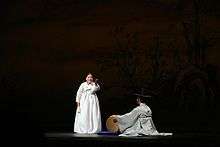Pansori
| Pansori | |
|
Pansori performance at the Busan Cultural Center in Busan South Korea | |
| Korean name | |
|---|---|
| Hangul | 판소리 |
| Revised Romanization | Pansori |
| McCune–Reischauer | P'ansori |
 |
Jingukmyeongsan
Song Man-gab singing a pansori danga in 1934 |
| Problems playing this file? See media help. | |
Pansori (Korean: 판소리, also spelled p'ansori) is a Korean genre of musical storytelling performed by a vocalist and a drummer.[1] The music is usually performed by one sorikkun (Korean: 소리꾼, a singer) and one gosu (a drummer playing a barrel drum called buk Korean: 북). The term pansori is derived from pan (Korean: 판, meaning "a place where many people gather"), and sori (Korean: 소리, meaning "sound"). UNESCO proclaimed the pansori tradition a Masterpiece of the Oral and Intangible Heritage of Humanity on November 7, 2003.
History
Origins
Pansori is thought to have originated from muga (무가; 巫歌), or shamanistic songs. Pannorum (판놀음), or non-ritualistic public entertainment, has also heavily influenced pansori[2] as pansori is a type of pannorum.[3]
Joseon Dynasty
Pansori originated in the 17th century, in the middle of the Joseon Dynasty (1392-1897).[1] The more 'mature' forms of pansori emerged only in the 18th century. The 19th century is considered the golden age of pansori, with an increase of popularity and advancement in the techniques.[2] During the first half of the 19th century, vocal techniques and melodies intended to appeal to the upper class were mainly used. However, folk tunes were also incorporated to broaden the musical vocabulary. A major development in this period was made by Shin Jae-hyo (1812 - 1884). He reinterpreted and compiled songs to fit the upper class and also trained the first notable female singers. The first female pansori singer recorded was Jin Chae-seon. In the second half of the 19th century, new advancements were made in the form of new variations and versions.[2] By the end of the Joseon period, pansori was performed for and enjoyed by the House of Yi.[2][4]
20th century
Due to the presence of a Japanese government and westernization, pansori declined in popularity. Sound recording and reproduction technology changed the listening experiences. There was also an abundance of female singers following the professional career of Jin Chae-son, a student of Shin Chae-hyo and the first professional pansori singer. Also, pansori dancing troupes were popular in the mid-20th century, but declined in popularity in the 1960s.[2] Due to the decrease of the popularity of pansori[2] and the modernization of South Korea, pansori was declared a National Intangible Cultural Property in 1964.[1] Due to this, pansori has regained popularity, both scholarly and practical, an awareness of its cultural value,[2] and institutional support.[1]
21st century
UNESCO proclaimed the pansori tradition a Masterpiece of the Oral and Intangible Heritage of Humanity on November 7, 2003.
Madang
Twelve stories sung as pansori in the mid-Joseon Dynasty are referred to as the twelve madang (열두마당). Those stories are illustrated in the books Gwanuhi (관우히; 觀優戱) and Joseon Changgeuksa (조선창극사; 朝鮮唱劇史).[3] Of those twelve, only five are currently performed. Those stories are: Chunhyangga, Simcheongga, Heungbuga, Sugungga, and Jeokbyeokga.[2][3] Contemporary performances of the madangs differ greatly from the original, enhancing some popular portions while reducing others, and mostly performing sections instead of the entire work.[2]
Musical style
There are five elements for the musical style of pansori: jo (조; 調); jangdan (장단; 長短); buchimsae (붙임새); je (제; 制); and vocal production.[5]
Jo
Jo (조; 調; also spelled cho) refers mostly to the melodic framework of a performance.[2] In terms of music in Western culture, it comparable to the mode and key, though jo also includes the vocal timbre and emotions expressed through singing. Types of jos include: chucheonmok (추천목; 鞦韆-); Gyemyeonjo (계면조; 界面調; also called seoreumjo 서름조, aewonseong 애원성); seokhwaje (석화제); and seolleongje (설렁제).[5]
Jangdan
Jangdan (장단; 長短) is the rhythmic structure used.[5] Jangdan is used to show emotional states[2] corresponding to the narration of the singer.[5] Jangdan is also used with the appearances of certain characters.[2] Some types include: jinyang (진양); jungjungmori (중중모리); jajinmori (자진모리); and hwimori (휘모리)[5]
Buchimsae
Buchimse (붙임새) refers to the method in which words in pansori are combined with the melodies. The meaning refers more specifically to combinations of words with irregular rhythms. The word is a combination of two Korean words, buchida (붙이다 "to combine") and sae (새 "appearance, form"). The two types of buchimsae are: daemadi daejangdan (대마디 대장단) and eotbuchim (엇붙임).[5]
Je
Je (제; 制) refers to a school of pansori[5]
Gallery
 Heungbuga performed by Ahn Suk-seon, Seoul, South Korea, 2006.
Heungbuga performed by Ahn Suk-seon, Seoul, South Korea, 2006.- Pansori performance at the Busan Cultural Center in Busan South Korea
 A young Pansori singer at Edinburgh festival.
A young Pansori singer at Edinburgh festival.
Famous pansori singers
- Kim So-hee
- Song Man-gap
- Ahn Suk-seon, one of the more important educators in this field.
- Im Bang-ul
- Pak Tongjin
See also
- Changgeuk
- Sopyonje — A critically acclaimed film that was a surprise box-office hit in Korea, telling the story of a family of pansori singers.
- Culture of Korea
- Korean music
- List of Korea-related topics
References
- 1 2 3 4 "Pansori epic chant". UNESCO. Retrieved January 13, 2014.
- 1 2 3 4 5 6 7 8 9 10 11 12 "p'ansori". Encyclopædia Britannica. Retrieved January 13, 2014.
- 1 2 3 판소리 [Pansori]. Encyclopedia of Korean Culture (in Korean). Academy of Korean Studies. Retrieved January 13, 2014.
- ↑ "What is Pansori?" (PDF). National Gugak Center. Retrieved January 13, 2014.
- 1 2 3 4 5 6 7 "Musical structure and expression of Pansori" (PDF). National Gugak Center. Retrieved January 14, 2014.
External links
| Wikimedia Commons has media related to Pansori. |
- Youtube Pansori introduction video by UNESCO
- Pansori song
- Two Brothers by Grace Andreacchi is a version of the pansori tale 'Heungbu and Nolbu' for English spoken drama.
